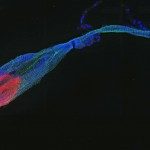Link to Pubmed [PMID] – 11677628
J. Mol. Evol. 2001 Dec;53(6):680-9
This paper deals with phylogenetic relationships among a set of 90 clinical strains representative of the worldwide diversity of the Mycobacterium tuberculosis complex (Kremer et al. 1999) using eight independent genetic markers: IS6110, IS1081, the direct repeat (DR) locus, and five variable number of tandem DNA repeat loci (VNTR). In a preliminary experiment, phylogenetic trees based on single markers were constructed that led to the detection of some similarities between the VNTR-based and the spoligotyping-based phylogenetic trees. In the second step, a more global phenetic approach based on pairwise comparison of strains within each typing system was used, followed by calculations of mean genetic distances based on all the eight loci and the use of the neighbor-joining algorithm for tree reconstruction. This analysis confirmed our preliminary observations and suggested the existence of at least two new phylogeographical clades of M. tuberculosis, one defined as the “East African-Indian family” (EA-I), which may find its origin on the African or Asian continents, and the other as the “Latin American and Mediterranean” (LA-M) family. The existence of these two families was also validated by an independent phylogenetic analysis of spoligotyping on a larger set of shared types (n = 252) and further corroborated by VNTR and katG-gyrA results. The potential origin of these families of bacilli is discussed based on cattle domestication and human migration history. In conclusion, the information contained in insertion sequence and repetitive DNAs may serve as a model for the phylogenetic reconstruction of the M. tuberculosis complex.

